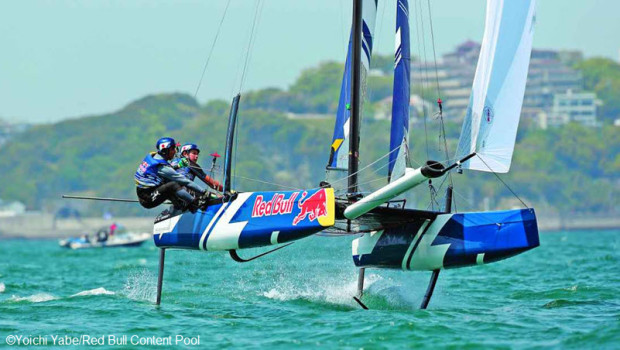Recognizing A Few Truths About Foiling
Published on August 11th, 2015
by Craig Leweck, Sailing World
“It’s what the kids want to be doing,” says the America’s Cup skipper, wearing the Red Bull cap of his sponsor, a brand that promotes extreme sports. “These boats are awesome to sail,” says the skipper’s mate, pleased about the platform now used in the America’s Cup.
It’s foiling, and it’s all the rage.
Sailing has incurred progressive steps in equipment, from sails to cordage to spar and hull construction. The advancement of canting keels was significant, but foiling is the most transformative step I’ve seen in my lifetime. When a boat is fully foiling, it enters a different dimension. It is flying.
While hydrofoil technology is nothing new, it was Rohan Veal’s persistence to apply the practice to the International Moth, as well as volumes of video he shared online, that elevated foiling to the current conversation. When Veal became the first to win a Moth world championship with foils in 2005, the development class was never the same. It’s no surprise the foiling Moth was born from Australian thinking, as skiff sailing and lightweight keelboats are in their DNA, but the high-performance wave was already extending beyond their shores. Once stodgy keelboat fleets in the United States had new designs planing downwind, with upwind performance aided by “damn-the-torpedos” gut hiking.
This trend toward high-performance boats prompted another shift—toward expertise. These speedy designs require more skill to sail. Their tune and trim are twitchier, crew work needs to be sharper, and helming demands more technique. The game is becoming far more technical, resulting in the blooming industry of professional coaches and crew. More investment is being made to participate in what is meant to be a recreational pursuit. These boats may be more fun to sail, but they are catering toward a smaller market. It’s not a template to grow the sport, and now foiling is raising the bar.
The 34th America’s Cup demonstrated how a 72-foot boat could be lifted, balancing on a few feet of carbon foils, while retaining buoy-racing maneuverability. The application of foiling appendages seemed limitless. The smart people quickly got to work, designing foiling boats to bring to market for those people eager to ride this most transformative wave. As exciting as the future looks, with the advancement of high-altitude sailing in the sport, a few truths may hamper its growth. – Read on
————————–
Look for Scuttlebutt editor Craig Leweck’s monthly column ‘Left Coast, Right Brain’ in Sailing World magazine.









 We’ll keep your information safe.
We’ll keep your information safe.